Neurotransmitters, their types and functions
Neurotransmitters are chemicals created by the body that transmit signals (ie, information) from one neuron to the next through contact points called synapses. When this happens, the chemical substance is released by the vesicles of the pre-synaptic neuron, crosses the synaptic space and acts by changing the action potential in the post-synaptic neuron.
There are different neurotransmitters, each with different functions. In fact, the study of this class of substances is fundamental to understanding how the human mind works. In this publication, we will review some of the most significant neurotransmitters.
I want to take the opportunity to let you know that a few days ago, I made a publication regarding the Sinapsis, this publication can be found in this LINK.
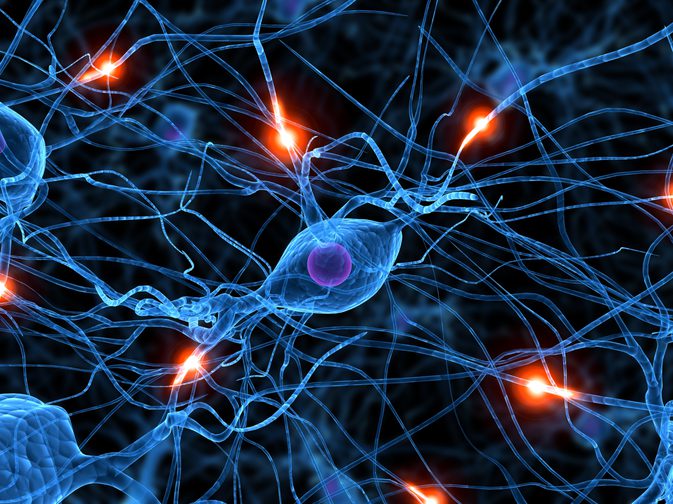
Main neurotransmitters and their functions
The list of known neurotransmitters has been increasing since the 1980s, and more than 60 have now been counted.
This is not strange, considering the complexity and versatility of the human brain. It produces all kinds of mental processes, from the management of emotions to the planning and creation of strategies, through the realization of involuntary movements and the use of language.
All this variety of tasks has many neurons behind, coordinating with each other to make the different parts of the brain function in a coordinated way, and for this it is necessary that they have a communication mode capable of adapting to many situations.
The use of different types of neurotransmitters allows to regulate in different ways the way in which one or other groups of nerve cells are activated. For example, a certain occasion may require serotonin levels to go down and dopamine levels to rise, and that will have a determined consequence in what happens in our mind. Thus, the existence of the wide variety of neurotransmitters allows the nervous system to have a wide range of behaviors, which is necessary to adapt to a constantly changing environment.
But what are the most important neurotransmitters in the human body and what functions do they perform? The main neurochemicals are mentioned below.
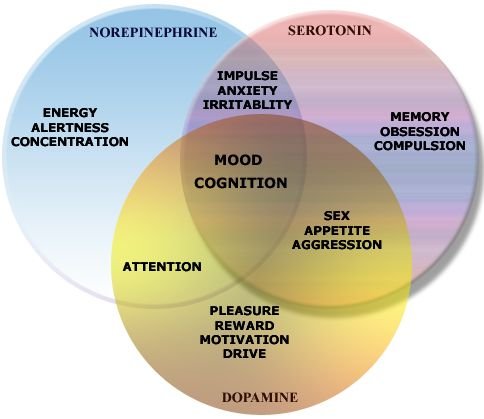
Serotonin
Some of these substances can only be found in certain types of cells and have very specific functions (so many of them must still be discovered), but others act both in the brain and outside of it. This is the case, for example, of serotonin, also known as 5-HT.
The 5-HT is deeply integrated into the functioning of the human body and learning from memory all its functions can be very intricate. However, in this summary you can know six of the main effects that serotonin has on the human body.
This neurotransmitter is synthesized from tryptophan, an amino acid that is not manufactured by the body, so it must be provided through the diet. Serotonin (5-HT) is commonly known as the happiness hormone, because low levels of this substance are associated with depression and obsession.
In addition to its relationship with the state of mind, 5-HT performs different functions within the organism, among which stand out: its fundamental role in digestion, the control of body temperature, its influence on sexual desire or its role in the regulation of the sleep-wake cycle.
The excess of serotonin can cause a set of symptoms of different severity.
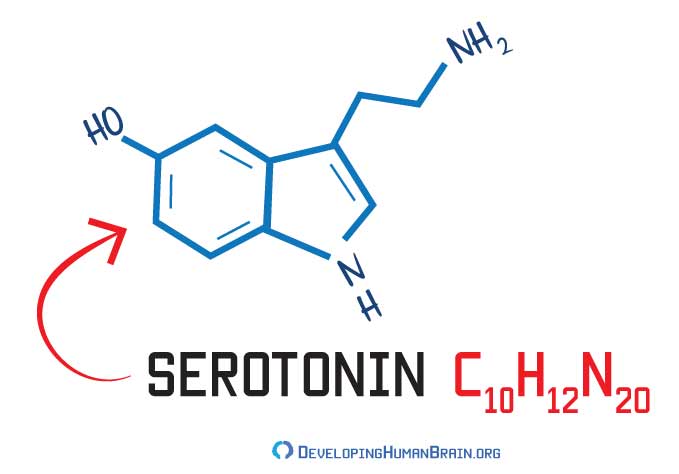
Dopamine
Dopamine is known as the pleasure neurotransmitter.
Dopamine, whose chemical formula is C6H3 (OH) 2-CH2-CH2-NH2, and its molecular formula C8H11NO2 is frequently mentioned as the cause of pleasurable sensations and the sensation of relaxation. However, with dopamine and the rest of neurotransmitters, something happens that prevents these situations from being related to a very specific function: they influence to a greater or lesser extent all the functioning of the brain in general, in all the emotional, cognitive and vitals that are carried out at that time.
That means that when dopamine or any other neurotransmitter is linked to emotional states or concrete mental processes, this is because the appearance of the latter is related to an increase in the level of certain neurotransmitters in some areas of the brain linked to that state or process in question.
In the case of dopamine, among its functions we also find the coordination of certain muscle movements, the regulation of memory, the cognitive processes associated with learning and even has been seen to have an important role in decision making.
The scientific community agrees that dopamine is also involved in the complex cognitive system that allows us to feel motivated and curious about some aspects of life.
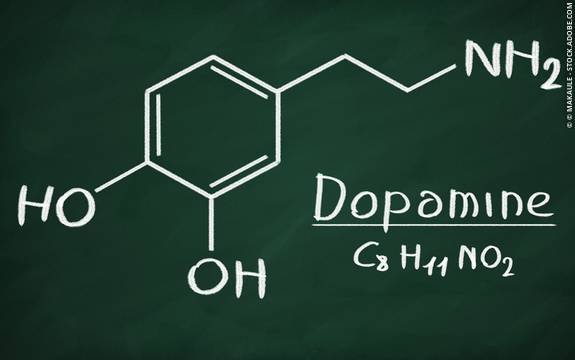
Adrenaline (epinephrine)
Adrenaline, also known as epinephrine, is one of those polyvalent substances that our body uses to regulate different bodily processes. It is a hormone, since it travels through the blood to reach different areas of the body and fulfill its task in the most remote corners of the body, but it is also a neurotransmitter, which means that it acts as an intermediary in the communication between neurons which is established in the synaptic spaces.
Below you can read the main characteristics of adrenaline and the functions it fulfills in our brain and beyond.
Adrenaline is produced by our body, specifically in the adrenal glands that are located above the kidneys. However, it can also be synthesized in laboratories to create drugs administered in cases of medical emergency. The latter, by itself, serves to give us an idea of the importance of the existence of a substance such as adrenaline for our organism, which intervenes in several of the most basic survival processes.
It is true that adrenaline fulfills many functions, but that does not mean that we can not recognize a more or less clear pattern in the different effects it has on us. This pattern can be summarized in the following: adrenaline is the hormone and the neurotransmitter of situations in which we have to be alert and activated. Said in other words, the adrenaline predisposes us to react quickly and prepares us to get the most out of our muscles when it is necessary to move with a certain speed, either because of the danger we run or to find ourselves in situations where we are It offers the opportunity to earn something if we are agile enough.
Adrenaline prepares us for situations in which we need to be specially activated both physically and psychologically. That is why it can be said that adrenaline triggers survival mechanisms that are put in place in emergency situations, such as those in which danger is perceived or must be reacted quickly.
Adrenaline does not act globally activating our organism, since there is no single "spring" that puts us in that state of alert. Instead, it goes to different parts of the body to produce different effects that, in their interaction with each other and with the rest of vital functions, result in activation.
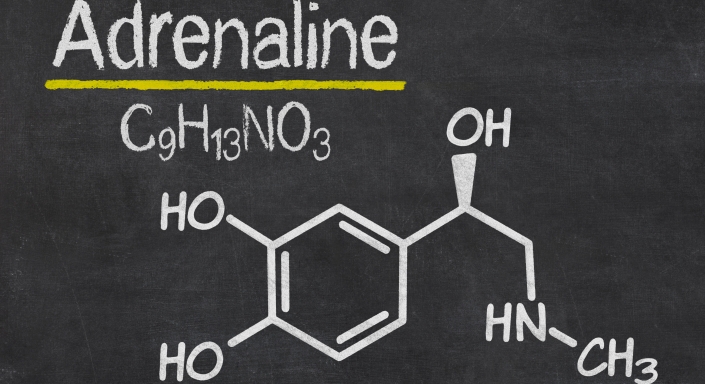
Endorphins
Endorphins are chemical substances produced by the body itself that structurally are very similar to substances such as opium, morphine or heroin but without having harmful effects for our body. It is believed that the etymology of the term Endorphins, has its origin in the words "endo" that means inside and "morphine" because of the effects it causes that are very similar to Narcotics.
It is estimated that we have around twenty types of Endorphins distributed throughout the body, a part of them we find them in the pituitary gland and are responsible for neuronal communication. These chemicals produce an analgesic effect, so they stimulate pleasure centers of the brain and create moments of great satisfaction that help eliminate discomfort or painful sensations.
When we get to feel some kind of pain, Endorphins act as an endogenous analgesic and help us to inhibit the transmission of pain to the brain.
Endorphins are produced by various sensations, may be due to pain or stress, they also influence our appetite, the release of sex hormones and even have to do with the strengthening of our immune system. When we feel pleasure for something these substances multiply and send messages to our brain, specifically to our lymphocytes and other cells that are responsible for defending us from viruses and bacteria that could attack our body.
Endorphins have a very short life as they are eliminated by certain enzymes that our body produces. It is like a measure to maintain the balance of our body but without hiding alarm signals or stronger symptoms.
There are many ways to stimulate the production of endorphins, either with food, exercise or various activities, but the truth is that when we perform pleasurable activities appears in the body a greater flow of these hormones, which causes a change in our attitude and our mood improves considerably.
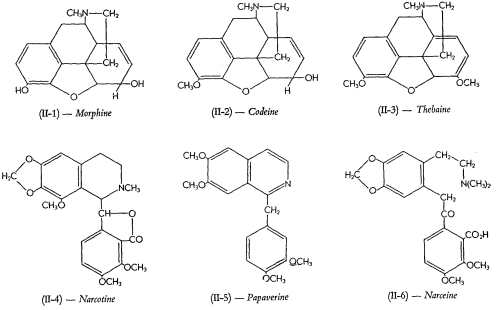
Acetylcholine
Acetylcholine is the specific neurotransmitter in the systems of the somatic nervous system and in the ganglionic synapses of the autonomic nervous system.
It is a chemical that allows the operation of a large number of neurons and, at the same time, allows the performance of various brain activities.
It was the first neurotransmitter isolated, conceptualized and characterized, for what according to many scientists is the most "old" substance of the brain.
Acetylcholine was described pharmacologically by Henry Hallet Delt in 1914 and subsequently confirmed by Otto Loewi as a neurotransmitter.
The main activity of acetylcholine lies in the cholinergic system, that system that is responsible for producing and synthesizing acetylcholine.
Regarding its most important effects, it highlights muscle contraction, movement, digestive and neuroendocrine processes, and the activation of cognitive processes such as attention and arousal.
The functioning of this neurotransmitter occurs in the brain of mammals information between neurons is transmitted through a chemical called neurotransmitter.
This substance is released at the synapse in response to a specific stimulus and upon release transmits a certain information to the next neuron.
The neurotransmitter that segregates acts in specialized and highly selective receptor sites, in this way, since there are different types of neurotransmitters, each one of them acts in certain systems.
Thus, a cholinergic neuron may produce acetylcholine (but not other types of neurotransmitters), likewise, a cholinergic neuron may produce specific receptors for acetylcholine but not for other types of neurotransmitters.
Thus, the exchange of information that acetylcholine performs is carried out in neurons and certain systems and denominated as cholinergic.
For acetylcholine to act requires a transmitting neuron that produces this substance and a receptor neuron that produces a cholinergic receptor that is capable of transporting acetylcholine when it is released from the first neuron.
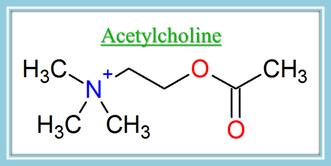
Glutamate
Possibly it has been one of the most extensively studied neurotransmitters in the nervous system. In recent years, its study has been increasing due to its relationship with various neurodegenerative pathologies (such as Alzheimer's disease), which has made it a powerful pharmacological target in various diseases.
It should also be mentioned that given the complexity of its receptors, this is one of the most complicated neurotransmitters to study.
The synthesis process of glutamate has its beginning in the Krebs cycle, or cycle of tricarboxylic acids. The Krebs cycle is a metabolic pathway or, for us to understand, a succession of chemical reactions in order to produce cellular respiration in the mitochondria. A metabolic cycle can be understood as the mechanism of a clock, in which each gear fulfills a function and the simple failure of a piece can cause the clock to spoil or not mark the time well. The cycles in biochemistry are the same. A molecule, by means of continuous enzymatic reactions - clock gears -, changes its form and composition with the aim of giving rise to a cellular function. The main precursor of glutamate will be alpha-ketoglutarate, which will receive an amino group by transamination to become glutamate.
It is also worth mentioning another quite significant precursor: glutamine. When the cell releases glutamate into the extracellular space, the astrocytes - a type of glial cell - recover this glutamate, which, through an enzyme called glutamine synthetase, will become glutamine. Then, the astrocytes release the glutamine, which is recovered again by the neurons to be transformed back into glutamate. And possibly more than one will ask the following: And if they have to return glutamine back to glutamate in the neuron, why does the astrocyte turn glutamine into poor glutamate? Well, I do not know either. Perhaps it is that astrocytes and neurons do not agree or maybe Neuroscience is that complicated. In any of the cases, I wanted to review the astrocytes because their collaboration accounts for 40% of the turnover of glutamate, which means that most of the glutamate is recovered by these glial cells.
There are other precursors and other pathways through which the glutamate that is released into the extracellular space is recovered. For example, there are neurons that contain a specific glutamate transporter -EAAT1 / 2- that directly recover the glutamate to the neuron and allow the excitatory signal to end.
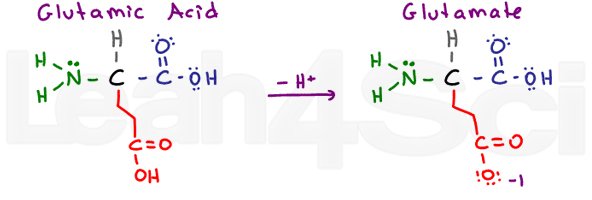
These are just one of the many neurotransmitters that our body has, in the future I will be talking in more detail and expanding the amount of neurotransmitters to explain.
Classification of neurotransmitters
Neurotransmitters can be classified as follows:
Amines: They are neurotransmitters that derive from different amino acids, such as tryptophan. In this group are: Norepinephrine, epinephrine, dopamine or serotonin.
Amino Acids: Unlike the previous ones (that derive from different amino acids), these are amino acids. For example: Glutamate, GABA, aspartate or glycine.
Purines: Recent research indicates that purines such as ATP or adenosine also act as chemical messengers.
Gases: Nitric oxide is the main neurotransmitter in this group.
Peptides: Peptides are widely distributed throughout the encephalon. For example: endorphins, dynorphins and tachykinins.
Esters: Acetylcholine is found in this group.
Thanks for reading my publication I hope you liked it.
For more information visit this Links
http://catalinacevedomejia.com/como-funcionan-las-endorfinas/
https://www.smartdrugsforthought.com/
https://www.lifeder.com/acetilcolina/
https://es.wikipedia.org/wiki/Neurotransmisor
As clinical chemist i like your post and i will keep in touch with you! Today i want to sensitize people as it is the internatinal childhood cancer day. Read my post if you want and feel free to comment! https://steemit.com/steemstem/@redqueen7/15-february-the-international-childhood-cancer-day
Thanks for reading my post, I will be aware of your blog, I follow you, a greeting.
h014, s0y 31 b0t d3 @luiscordon, y0 r3g410 upv0t3s
Hola
Congratulations @daylen! You received a personal award!
Click here to view your Board
Do not miss the last post from @steemitboard:
Congratulations @daylen! You received a personal award!
You can view your badges on your Steem Board and compare to others on the Steem Ranking
Vote for @Steemitboard as a witness to get one more award and increased upvotes!